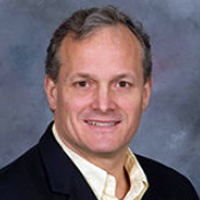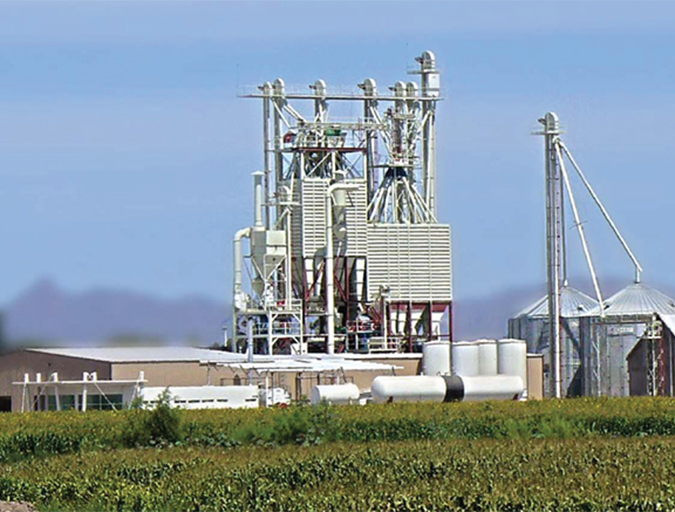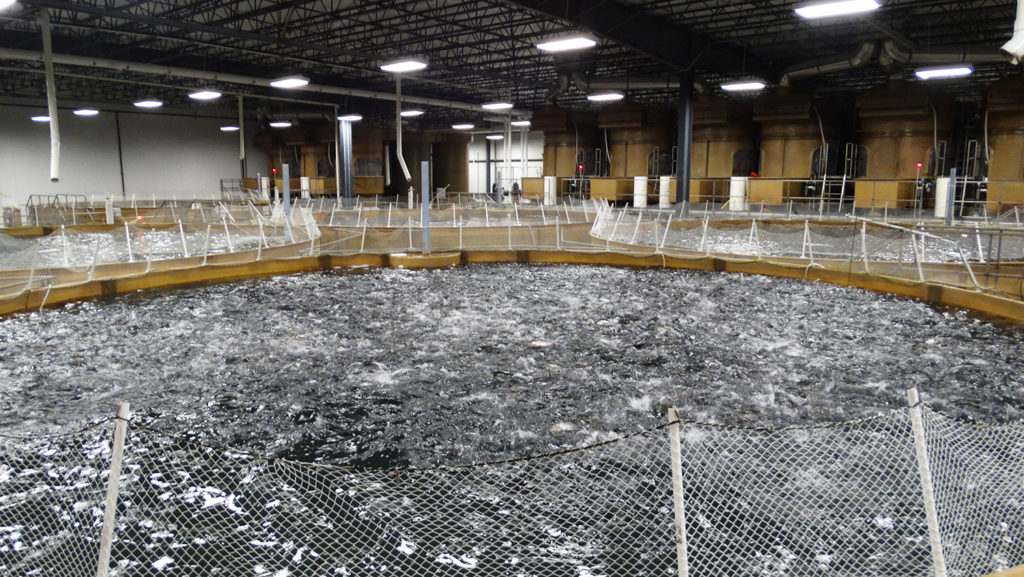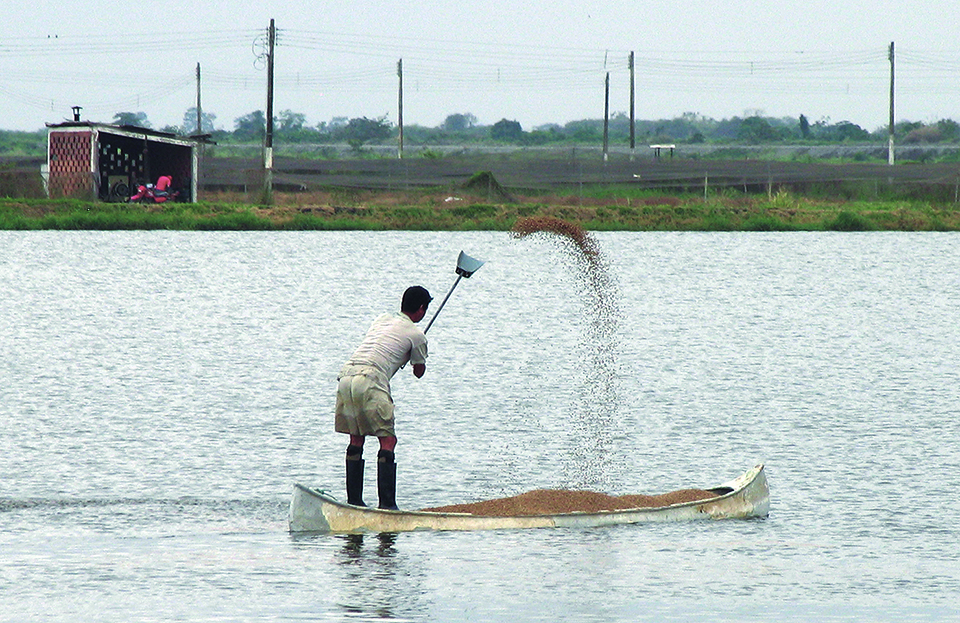Pumps utilized by The Conservation Fund Freshwater Institute have minimal impacts on fish

Various systems have been utilized to move culture animals between production units or into transport vehicles at harvest. Harvest “pumps,” for example, transfer fish from ponds or tanks along chutes or through tubes along with an artificial flow of water generated by the pumps.
A new transfer system based on compressed air moves fish from unit to unit through flexible tubing. The air pressure differential introduced across the fish results in a net force that propels the fish through the tube. The patented new WhooshhTM system uses very little water (less than 34 L/hour), which is only used to lubricate the interior of the tube.
Technology applications
The technology was originally developed to safely and gently transport delicate food objects such as apples, citrus and peaches. It was later tested to move salmon over dams instead of using fish ladders, trap and haul, or other fish-handling equipment.
For the past two years, the Washington Department of Fish and Wildlife has used the transport system to separate endangered chinook salmon from hatchery-bound fish by moving the hatchery-bound fish up a steep river bank into waiting hatchery trucks. Previously, hatchery workers had to dump the fish into totes and hand carry them up the bank to the tanker truck.
This past summer, the volitional entry function of the system was tested at the Buckley Diversion Dam on the White River in Washington, USA. The test demonstrated that fish will follow the water flow and swim into the system on their own. In addition, the air-based system is being used to move harvested fish, and is in use in Norwegian salmon-processing plants.

RAS test
To evaluate the application of the transport method within a recirculating aquaculture system, the authors performed testing at The Conservation Fund Freshwater Institute in Shepherdstown, W.V, USA. Atlantic salmon of about 4-kg weight were harvested from the facility’s 150-m3 grow-out tank using a clam-shell grader to crowd fish to the sidewall drain box, which typically receives 90–95 percent of the flow through the tank and is relatively free of settleable solids. To harvest the fish, a normally vertical perforated door through the sidewall drain was lowered to open.
When the harvest wound down to only a few dozen remaining fish in the tank, the crowded fish were netted by hand and directed into the sidewall drain box without lifting them out of the water. A dewatering rack installed in the drain box separated the water flow from the fish before the fish were slid by hand into the box and an outlet sluice channel. Sliding the fish by hand into the outlet channel allowed manual orientation of the salmon either head first or tail first to test fish transfer through the system.
In the test, the outlet sluice channel outlet was connected to the intake of the system pump house or “accelerator.” The system uses air to first gently pull and then push the salmon through a flexible hygienic tube with minimal water to substantially increase the distance, height and speed that large harvest-size salmon can be transferred.
The system tube was installed quickly using a wire cable to suspend the tube. The salmon were then transferred through the tube from the accelerator to the finishing/purging tanks in only a few seconds. Unlike gravity-feed fish transfer pipes, this system allows the fish to move up and over equipment, taking advantage of the unused space above the floor and equipment.
Fish-friendly
The salmon were oriented with roughly half transferred head first into the system and the other half transferred tail first. To determine if transferring the fish either head first or tail first had any negative impact, the treatment groups were separated and held for six days in the purge/finishing tank.
The results were encouraging. While one salmon was lost immediately after transfer because the outlet of the tube was initially misaligned, and the fish collided with the wall of the tank, the tube was adjusted, and the test continued. Other than that first fish, no dead fish were found in the tank during the six-day depuration/finishing period.
After six days, all of the fish were anesthetized and examined for wounds and bruising. There was little or no bruising on the salmon moved head first. However, some bruising was observed near the tails of a few fish that were transferred tail first.
Based on the bruising pattern, this bruising may have been inadvertently caused when pushing the fish backward into the dewatering PVC pipe used between the sidewall drain box and the entry to the accelerator. An easy modification to this PVC pipe would avoid this problem.
Water savings
Overall, this system was highly effective in rapidly moving large salmon through a 12-meter-long tube. Moving large fish without water offers a huge advantage, particularly in recirculating systems, because typical 30-cm-diameter fish pumps can require a flow of more than 4,000 L/minute to move fish.
Pumping these flows from one recirculating system to another or to a purging/finishing system can cause large water imbalances and sump drawdowns in these fairly closed systems if additional piping and pumping networks are not included to allow water flows to remain stable. Because accounting for water flow is critical in water recirculating systems, the technologies to transfer fish and water from grow-out systems and into finishing/purging systems should be detailed during the design phase.
Now that you've reached the end of the article ...
… please consider supporting GSA’s mission to advance responsible seafood practices through education, advocacy and third-party assurances. The Advocate aims to document the evolution of responsible seafood practices and share the expansive knowledge of our vast network of contributors.
By becoming a Global Seafood Alliance member, you’re ensuring that all of the pre-competitive work we do through member benefits, resources and events can continue. Individual membership costs just $50 a year.
Not a GSA member? Join us.
Authors
-

Steven Summerfelt, Ph.D.
The Conservation Fund Freshwater Institute
1098 Turner Road
Shepherdstown, West Virginia 25443 USA -
Travis May, Curtis Crouse
The Conservation Fund Freshwater Institute
-
Jeanne McKnight, Ph.D.; Vincent Bryan III
Whooshh Innovations
Bellevue, Washington, USA
Tagged With
Related Posts

Aquafeeds
The Bottom Line: Integrating feed manufacturing into fish or shrimp production operations
Incorporating feed manufacturing into an aquaculture business offers greater and more efficient product access, control and logistics, as well as additional profit potential. A feasibility study that plans for growth and includes both a business plan and economic analysis is a must.

Innovation & Investment
AquaBounty, with new RAS facility, hopes to win public support for GM salmon
Ron Stotish, CEO of AquaBounty Technologies, believes genetically modified salmon is no threat to its opponents and the outlook for AquAdvantage is good. With its purchase of the Bell Fish Co. RAS facility, commercialization will soon commence.

Aquafeeds
Aquaculture feed composition helps define potential for water pollution
A study found that feed for salmon and trout had higher organic carbon concentrations than did catfish, shrimp and tilapia feeds. Nitrogen and phosphorus concentrations were similar among salmon, trout and shrimp feeds, and higher than those in catfish and tilapia feeds.

Aquafeeds
Aquaculture Exchange: Andrew Jackson, IFFO
Aquaculture remains dependent on fishmeal and fish oil, crucial marine ingredients in aquafeeds, particularly at key life stages. Andrew Jackson, technical director at IFFO and one of the world’s foremost fishmeal experts, tells the Advocate that the two industries can coexist well into the future if properly managed.



